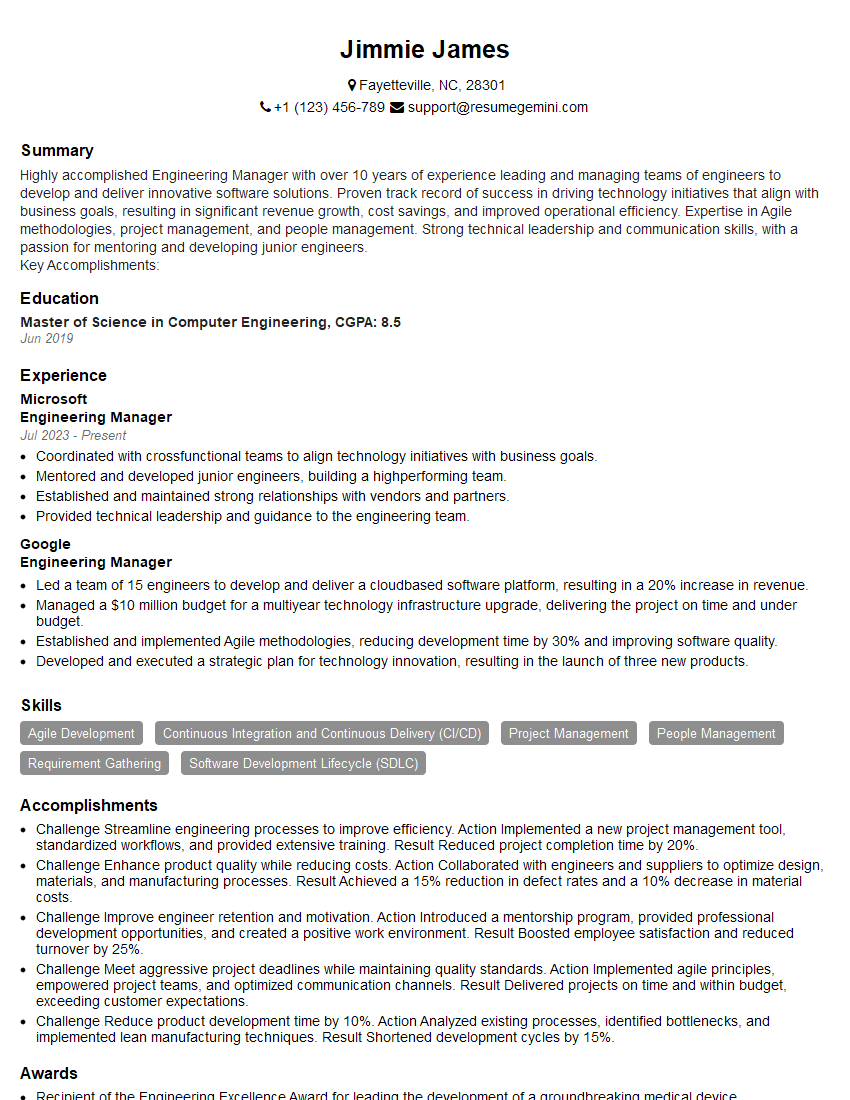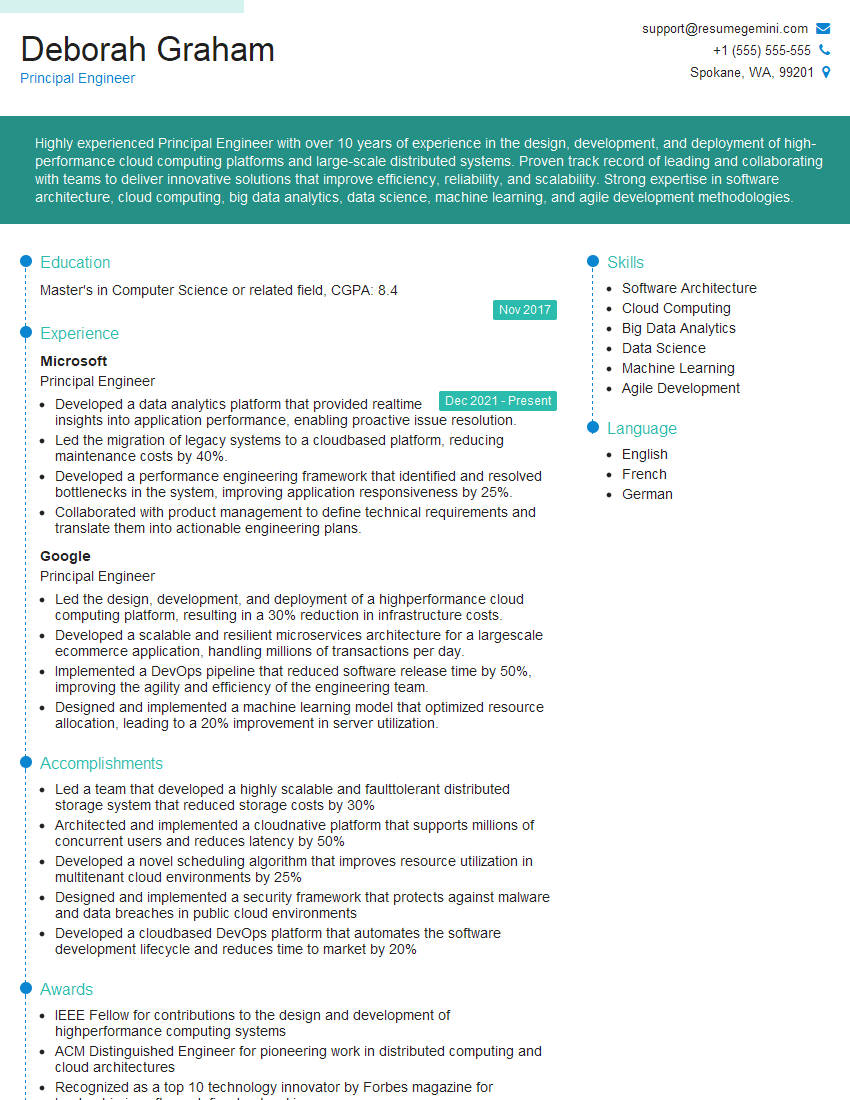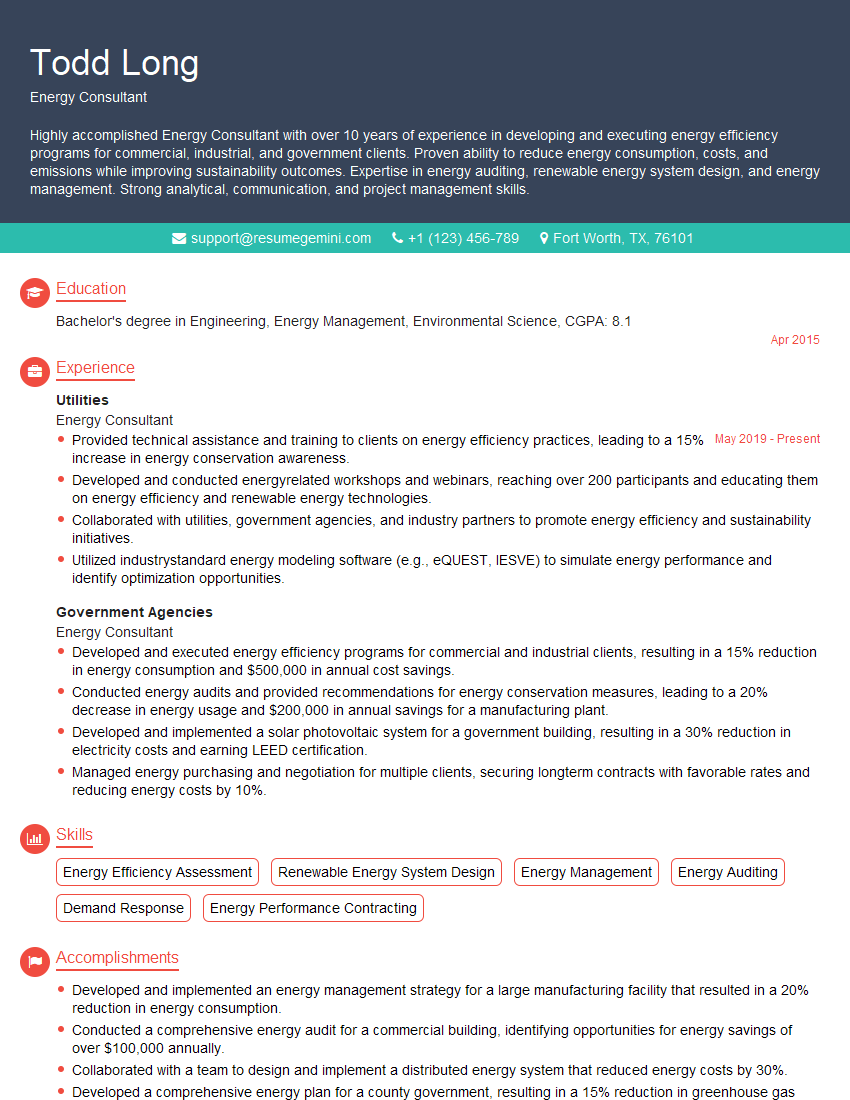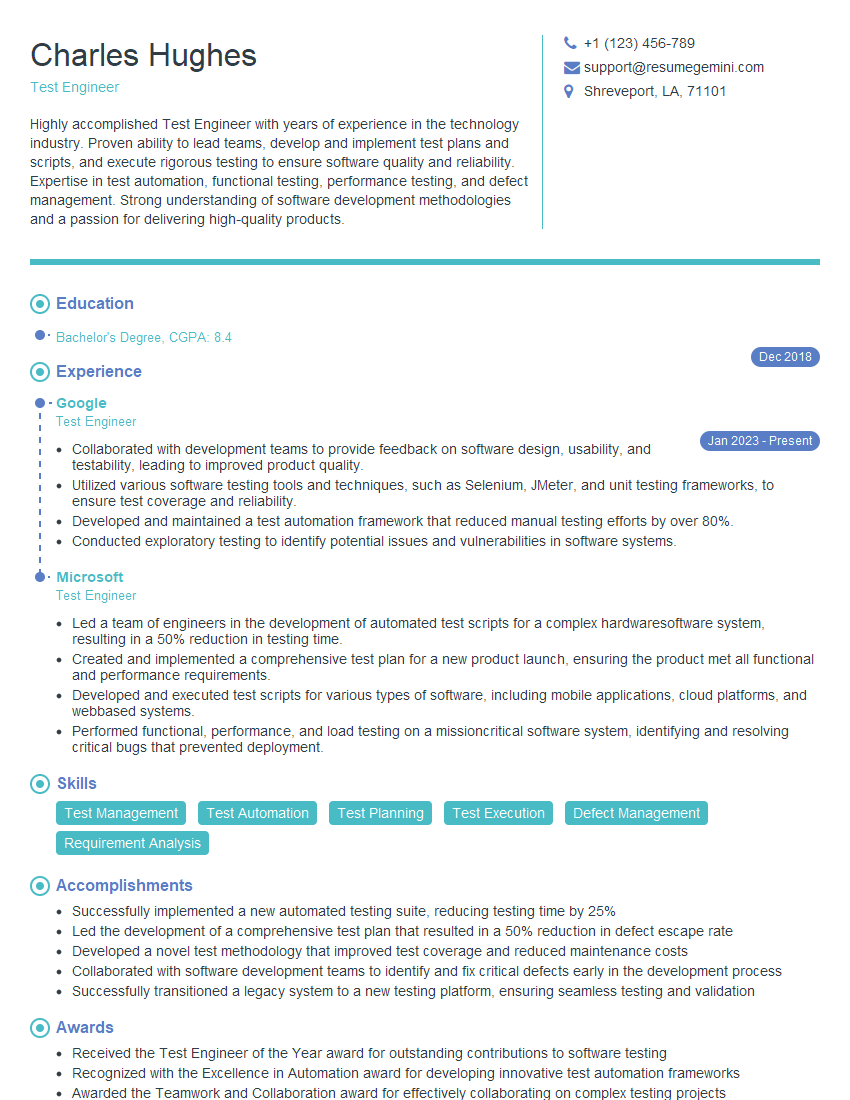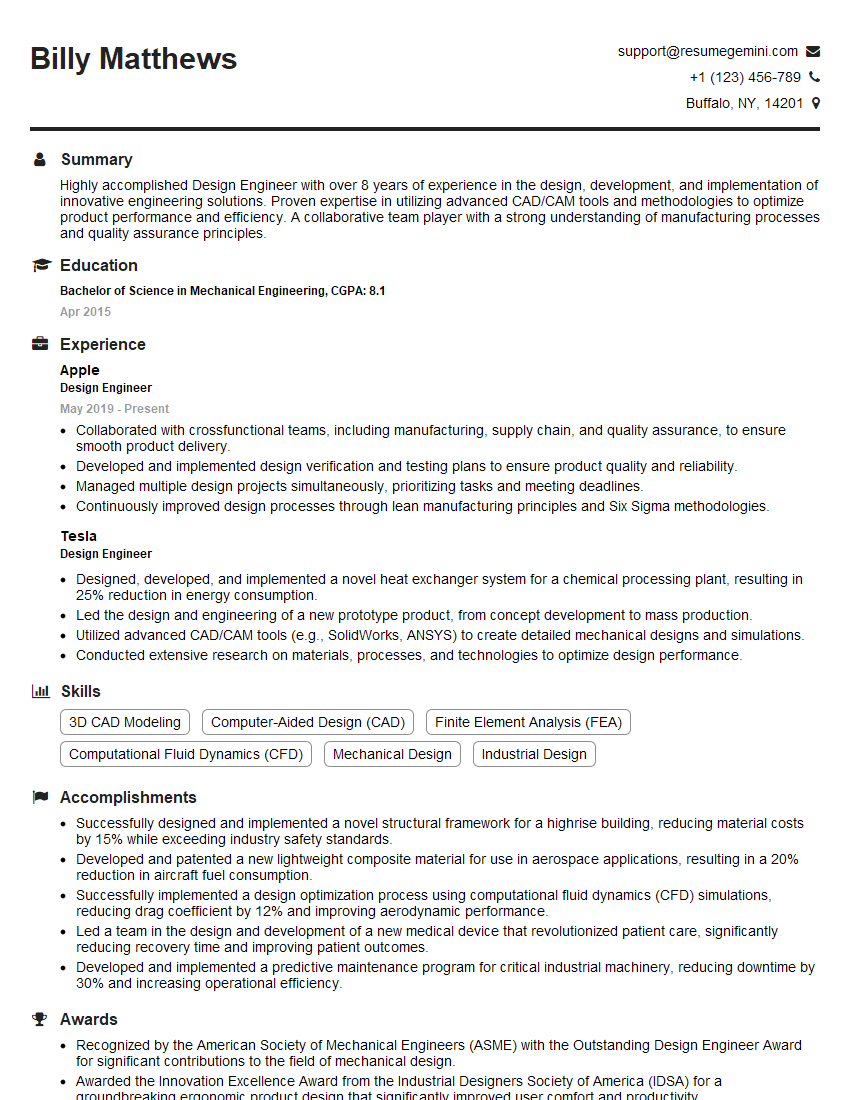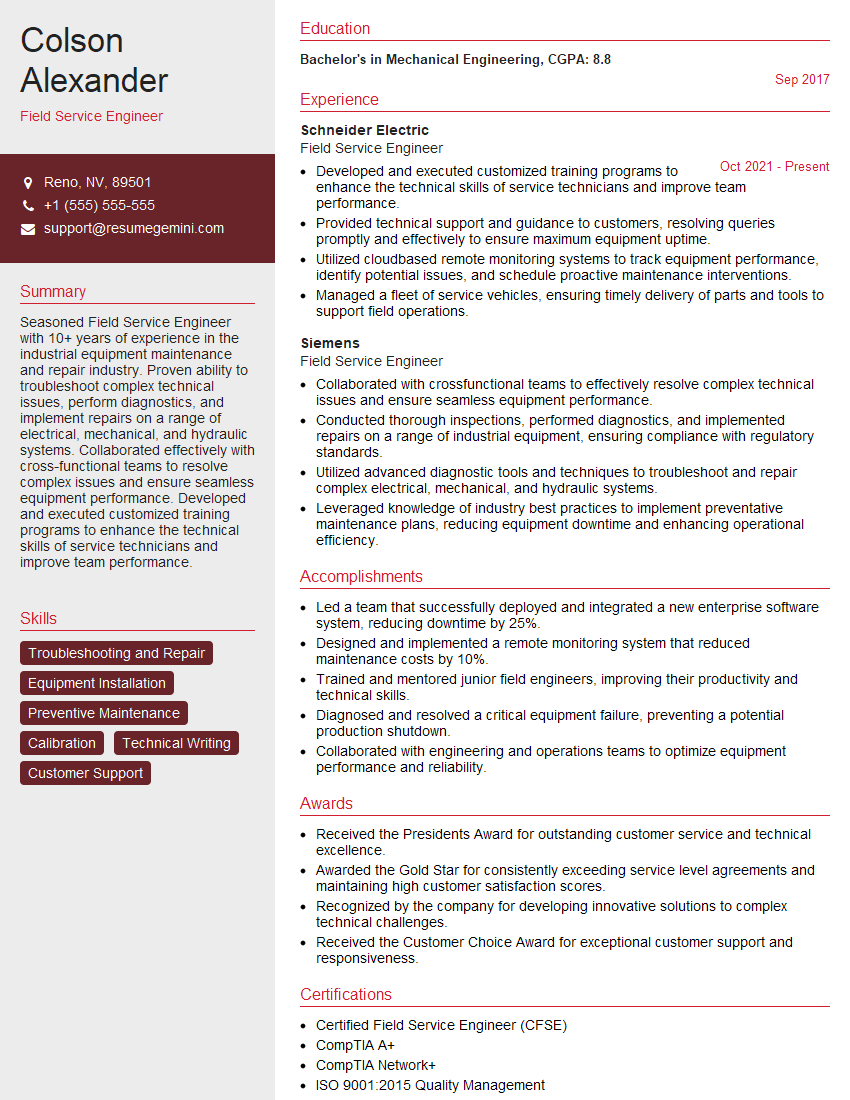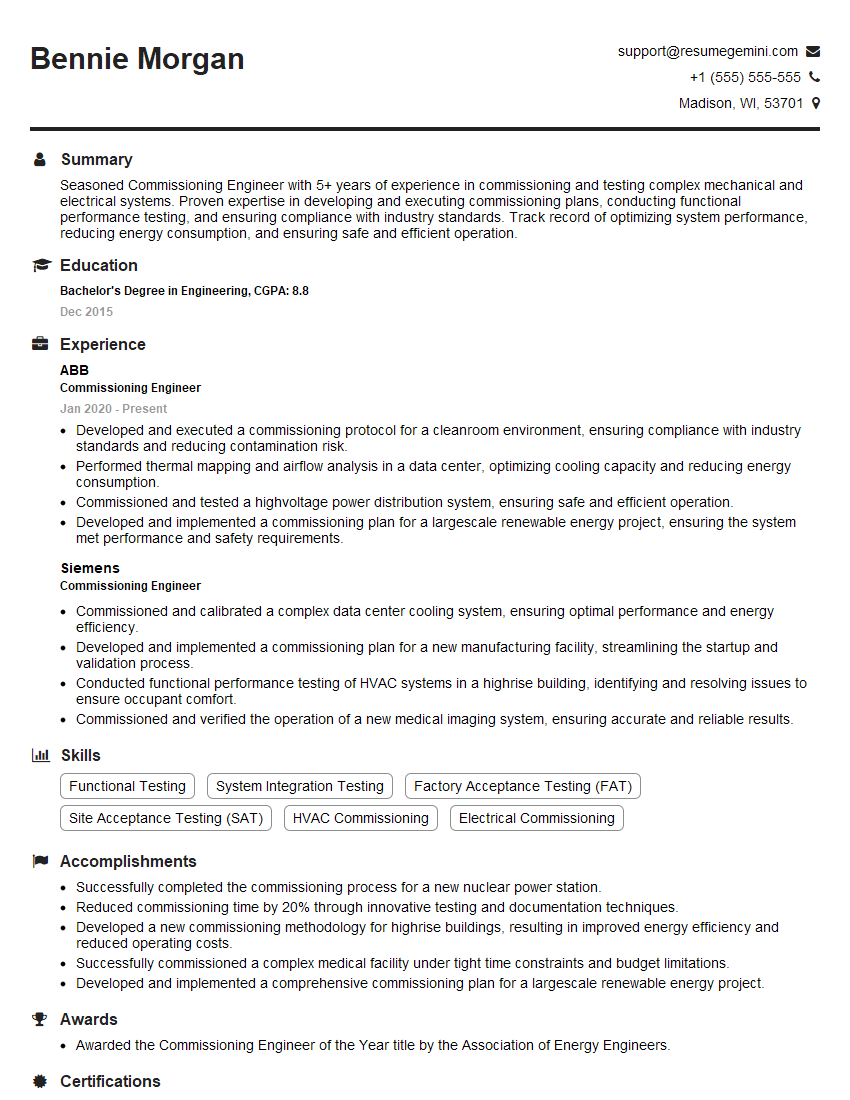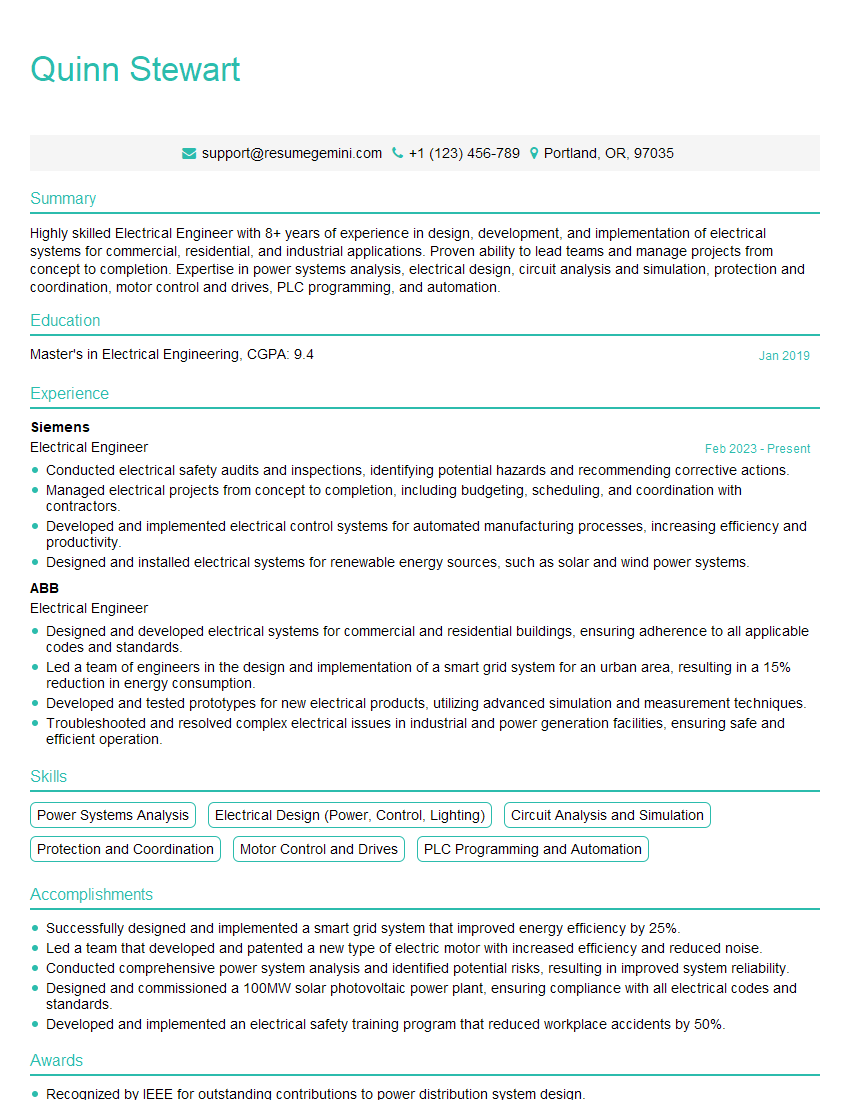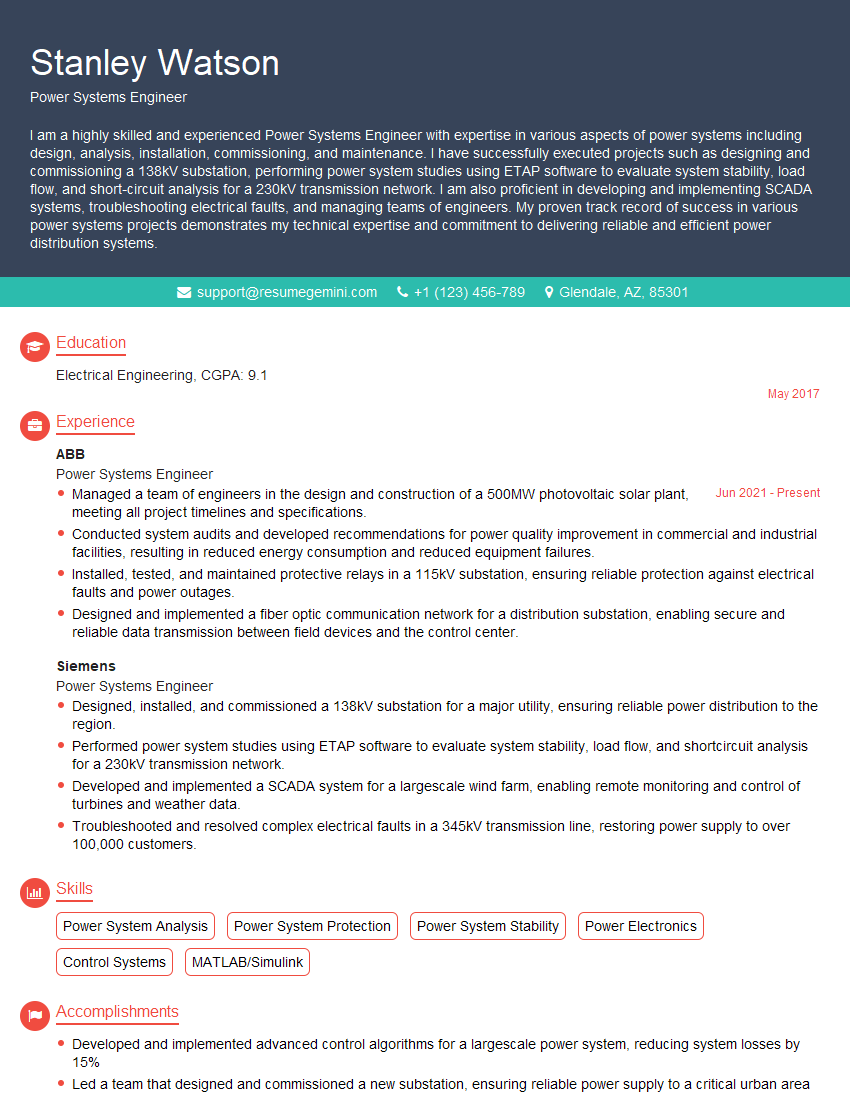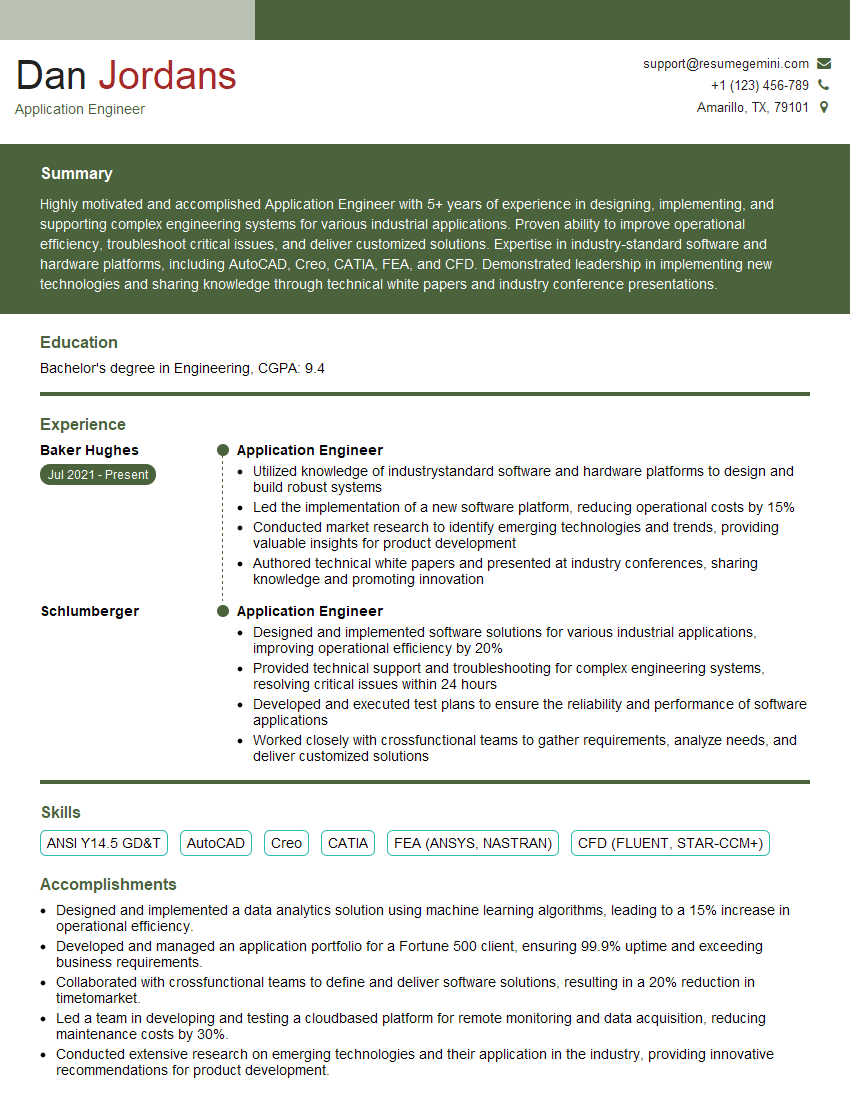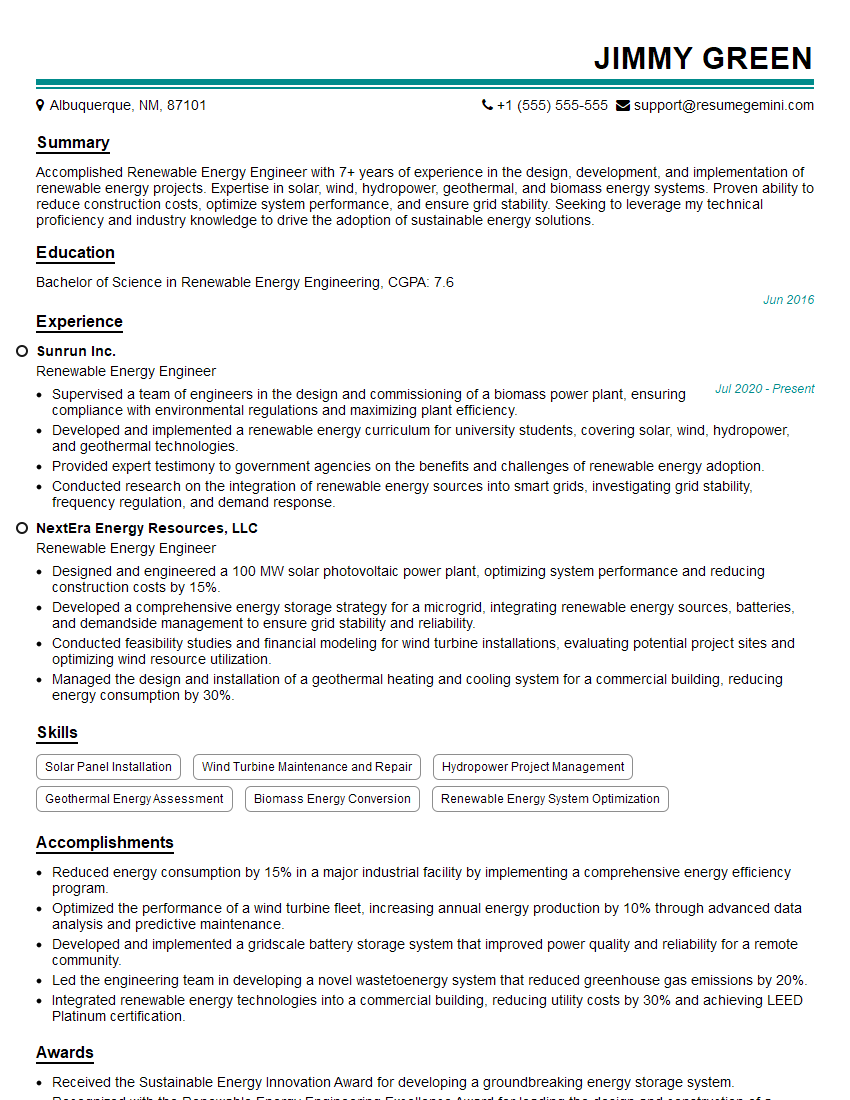Interviews are opportunities to demonstrate your expertise, and this guide is here to help you shine. Explore the essential IEEE Std 519 Compliance interview questions that employers frequently ask, paired with strategies for crafting responses that set you apart from the competition.
Questions Asked in IEEE Std 519 Compliance Interview
Q 1. Define IEEE Std 519 and its purpose.
IEEE Std 519, officially titled “IEEE Recommended Practices and Requirements for Harmonic Control in Electrical Power Systems,” is a widely recognized standard that provides guidelines for limiting harmonic distortion in power systems. Its primary purpose is to ensure the reliable and efficient operation of electrical equipment and systems by establishing acceptable levels of harmonic currents and voltages injected by various power system loads.
Think of it as a set of rules for maintaining a clean and healthy power supply. Without these guidelines, the cumulative effect of harmonic currents from numerous devices could severely impact the overall power quality, leading to malfunctions and equipment damage.
Q 2. Explain the different types of harmonic distortions.
Harmonic distortions are unwanted current or voltage waveforms that are multiples of the fundamental frequency (typically 50 or 60 Hz). There are several types, categorized based on their origin and characteristics:
- Current Harmonics: These are generated by non-linear loads like rectifiers, variable speed drives (VSDs), and switching power supplies. They are multiples of the fundamental frequency (e.g., 2nd, 3rd, 5th harmonics) and are injected into the power system.
- Voltage Harmonics: These are created as a result of current harmonics flowing through system impedances (transformers, cables, etc.). The system’s impedance acts as a filter, creating voltage distortions at the same harmonic frequencies as the current harmonics.
- Interharmonics: These are frequency components that are not integer multiples of the fundamental frequency. They are usually caused by cycloconverters, some types of adjustable-speed drives, or other power electronic devices.
Imagine a perfectly smooth sine wave representing the ideal power supply. Harmonic distortions add ripples and distortions to this smooth wave, affecting the quality of the electricity.
Q 3. Describe the limits for harmonic currents and voltages as per IEEE Std 519.
IEEE Std 519 provides limits for both harmonic currents and voltages, expressed as percentages of the fundamental frequency. The limits are dependent on the size of the load (in terms of its short-circuit current contribution) and the point of common coupling (PCC) where the harmonics are measured. The standard uses different tables for different system sizes, reflecting the ability of larger systems to absorb harmonics more effectively. In general, lower harmonic levels are allowed for smaller systems.
For instance, a larger industrial facility with a high short-circuit capacity will have higher allowable harmonic current limits than a smaller commercial building. It’s crucial to refer to the specific tables within IEEE Std 519 to determine the applicable limits for a particular installation. These limits are essential to prevent adverse effects on other connected loads and system components.
Q 4. What are the methods for mitigating harmonic distortion?
Several methods exist for mitigating harmonic distortion, and the optimal solution often involves a combination of techniques. Here are some key approaches:
- Passive Filters: These are tuned circuits (inductors and capacitors) designed to resonate at specific harmonic frequencies, thereby absorbing and attenuating those harmonics. They are cost-effective for specific harmonic frequencies but less flexible for changing harmonic profiles.
- Active Filters: These utilize advanced power electronics to actively compensate for harmonic currents by injecting opposite harmonic currents, effectively canceling out the distortion. They offer better flexibility and adaptability compared to passive filters.
- Harmonic Isolation Transformers: These transformers use specialized winding designs to reduce the flow of harmonic currents between different parts of the power system. They provide isolation and reduce the impact of harmonics on sensitive loads.
- Improved Load Design: Using loads that naturally produce less harmonic distortion (e.g., higher-quality power supplies with improved input filtering) can reduce the overall harmonic burden on the system.
- Proper Power System Design: This involves selecting appropriate equipment ratings, using proper grounding techniques, and ensuring that the power system impedance is adequately designed to minimize harmonic amplification.
The choice of mitigation method depends on factors like the amount of harmonic distortion, the sensitivity of loads, and the overall cost considerations.
Q 5. How do you measure harmonic distortion in a power system?
Measuring harmonic distortion in a power system involves using specialized instruments like power quality analyzers. These analyzers typically measure the voltage and current waveforms at the PCC, using Fast Fourier Transforms (FFTs) to decompose the waveforms into their individual frequency components. The results are then expressed as harmonic currents (in amps) or harmonic voltages (in volts) at each harmonic frequency, as well as THD.
The measurement process usually includes:
- Selecting the Measurement Location: The PCC is the critical point for measurement, as it represents the boundary between the customer’s equipment and the utility’s system.
- Using Appropriate Instrumentation: A power quality analyzer with sufficient bandwidth and accuracy is necessary to capture the harmonic content accurately.
- Data Acquisition and Analysis: The analyzer captures the waveforms over a specific period, and the FFT analysis provides the harmonic content in a tabular or graphical format.
Proper measurement techniques are vital for accurate assessment and appropriate mitigation strategies. Consider factors such as duration of measurements and potential interference from other sources.
Q 6. What are the key factors to consider when selecting harmonic mitigation equipment?
Selecting harmonic mitigation equipment requires careful consideration of several key factors:
- Type and Level of Harmonics: The specific harmonic frequencies and magnitudes present in the system determine the type of filter or compensator needed.
- System Impedance: The impedance of the power system affects the effectiveness of passive filters. Accurate impedance calculations are necessary for proper filter design.
- Load Characteristics: The type and variability of the loads affect the harmonic profile and, thus, the appropriate mitigation strategy. A solution that works well for one load may not be ideal for another.
- Cost and Maintenance: Active filters generally offer higher flexibility and performance but can be more expensive than passive filters. Maintenance costs and lifespan should also be factored in.
- Space Requirements: The physical size and space requirements of the mitigation equipment should be considered, particularly for larger systems.
- Future Expansion: The chosen equipment should ideally accommodate future expansion of the power system to avoid the need for upgrades in the near future.
Careful consideration of these factors is critical for selecting an effective and economical harmonic mitigation solution.
Q 7. Explain the concept of Total Harmonic Distortion (THD).
Total Harmonic Distortion (THD) is a single numerical value that represents the overall level of harmonic distortion in a voltage or current waveform. It’s expressed as a percentage of the fundamental frequency component. Specifically, it quantifies the ratio of the RMS value of the harmonic components to the RMS value of the fundamental frequency component.
For example, a voltage waveform with a THD of 5% means that the RMS value of all the harmonic components is 5% of the RMS value of the fundamental frequency component. A lower THD indicates cleaner power with less harmonic distortion. IEEE Std 519 provides limits for THD, ensuring the power system remains stable and does not experience significant degradation in power quality. THD is a valuable metric for assessing the overall impact of harmonic distortions on a power system.
Q 8. What are the consequences of exceeding IEEE Std 519 limits?
Exceeding the harmonic limits specified in IEEE Std 519 can lead to a range of detrimental effects on power systems and connected equipment. Think of it like exceeding the weight limit on a bridge – eventually, it will compromise the structural integrity.
- Equipment Malfunction: Harmonics can cause overheating in motors, transformers, and capacitors, leading to premature failure and costly repairs. For example, excessive harmonic currents in a motor can significantly reduce its lifespan and efficiency.
- Resonance Issues: Harmonics can interact with the power system’s natural resonant frequencies, leading to amplified harmonic currents and voltages. This is akin to pushing a child on a swing at just the right frequency – the amplitude increases significantly. Such resonance can cause severe overvoltages and damage sensitive equipment.
- Protection System Misoperation: Harmonics can interfere with the proper operation of protective relays, potentially leading to unnecessary tripping and power outages. Imagine a false fire alarm – it disrupts operations and causes unnecessary chaos.
- Increased Losses: Harmonics increase losses in power system components like transformers and transmission lines due to eddy currents and skin effect. This translates to increased energy consumption and higher operating costs.
- Power Quality Issues: Harmonics contribute to poor power quality, affecting the performance of sensitive electronic equipment. This can lead to data corruption, malfunction, and even complete system failure. Imagine a computer crashing due to a power surge caused by harmonics.
Q 9. How does IEEE Std 519 apply to different power system components (e.g., generators, converters)?
IEEE Std 519 applies differently to various power system components because each contributes to or is affected by harmonics in unique ways.
- Generators: Generators are typically considered sources of low-order harmonics (3rd, 5th, 7th, etc.). IEEE 519 provides guidelines for the acceptable levels of harmonic currents they inject into the system. Larger generators usually have a higher capacity to handle harmonic currents compared to smaller generators.
- Converters: Power electronic converters (e.g., rectifiers, inverters used in variable-speed drives) are major harmonic sources. They produce a wide range of harmonics, including high-order ones, demanding stricter compliance with IEEE 519 limits to prevent damaging other equipment. This is a particularly important consideration for large industrial installations with significant numbers of converters.
- Transformers: Transformers are susceptible to harmonic distortion, especially due to the increased eddy current losses caused by harmonic currents. They may also introduce harmonic distortion if they are saturated due to high harmonic currents. IEEE 519 considers the impact of harmonics on transformer heating and aging.
- Capacitors: Power factor correction (PFC) capacitors are particularly vulnerable to harmonic overcurrents. Resonance with system inductance can lead to capacitor overvoltage and failure. Therefore, careful consideration is necessary when using capacitors, and often special harmonic filters are employed.
IEEE 519 essentially sets limits on the amount of harmonic distortion that can be introduced by these components, ensuring the overall power system quality remains within acceptable bounds. The limits are dependent on the system’s size, type, and other factors.
Q 10. Explain the difference between individual and total harmonic distortion limits.
The difference between individual and total harmonic distortion (THD) lies in their scope: Individual harmonic distortion refers to the contribution of a single harmonic frequency, while total harmonic distortion encompasses all harmonic frequencies combined.
- Individual Harmonic Distortion: This represents the percentage of a specific harmonic frequency (e.g., 5th harmonic) relative to the fundamental frequency (50Hz or 60Hz). For example, a 5% 5th harmonic means the 5th harmonic voltage is 5% of the fundamental voltage. IEEE 519 sets individual harmonic limits to prevent specific harmonics from causing significant problems.
- Total Harmonic Distortion (THD): THD is a measure of the overall harmonic distortion present in a voltage or current waveform. It quantifies the combined effect of all harmonic frequencies. A high THD indicates significant harmonic distortion, affecting the quality of the power supply. IEEE 519 provides limits for both voltage and current THD, ensuring the overall system remains within acceptable parameters.
Imagine a choir: Individual harmonic distortion is like the contribution of a single singer, while THD is the overall sound quality of the entire choir. Even if individual singers aren’t too loud, a poorly coordinated choir (high THD) can produce an unpleasant sound. Similarly, even if individual harmonic levels are within limits, excessive overall harmonic distortion can still lead to issues.
Q 11. What is the role of power factor correction in mitigating harmonics?
Power factor correction (PFC) plays a crucial role in mitigating harmonics, but it’s not a direct solution; it needs careful consideration and often requires additional harmonic mitigation strategies.
PFC capacitors improve the power factor by compensating for the lagging reactive power drawn by inductive loads (like motors). However, if the system already has harmonic distortion, adding PFC capacitors can worsen the situation. Why? Because these capacitors can resonate with system inductances, amplifying specific harmonic currents and voltages, potentially leading to capacitor failure or other equipment damage.
Therefore, PFC should be carefully designed and often includes harmonic filters to avoid resonance problems. A well-designed PFC system, coupled with harmonic filters, improves the power factor and mitigates harmonics. It’s a balanced approach.
Think of it as trying to fix a leaky roof: Just patching one area (PFC) might not be enough if there are other leaks (harmonics). A complete solution involves addressing all leaks simultaneously using appropriate techniques (harmonic filters).
Q 12. Describe the importance of harmonic studies in power system design.
Harmonic studies are vital in power system design to predict and mitigate potential harmonic problems before they occur. It’s like designing a bridge with detailed calculations to ensure structural integrity rather than just hoping for the best.
Harmonic studies use software tools to simulate the behavior of the power system under different operating conditions, considering various sources of harmonic currents and the system’s impedance characteristics. The study identifies potential resonance points and predicts harmonic levels at different locations within the system.
This information is crucial for:
- Sizing equipment correctly: To ensure components can handle the predicted harmonic levels without overheating or premature failure.
- Designing appropriate harmonic filters: To suppress specific harmonic frequencies and prevent resonance issues.
- Selecting suitable equipment: To ensure equipment is compatible with the expected harmonic environment.
- Avoiding costly redesigns: Early identification of harmonic issues prevents expensive rework and equipment replacement down the line.
In essence, harmonic studies ensure that the power system is robust and operates reliably under real-world conditions with nonlinear loads.
Q 13. How do you determine the appropriate harmonic filter design for a specific application?
Designing an appropriate harmonic filter requires a systematic approach. It’s not a one-size-fits-all solution and depends greatly on specific conditions.
Here’s a step-by-step approach:
- Perform a thorough harmonic study: This is essential to identify the dominant harmonic frequencies and their magnitudes in the system.
- Determine filter specifications: Based on the harmonic study, determine the required attenuation for each harmonic frequency.
- Select the filter type: Common types include passive filters (consisting of inductors and capacitors), active filters (using power electronic converters), and hybrid filters (combining passive and active elements). The choice depends on factors like cost, complexity, and required performance.
- Determine filter rating: The filter must be rated to handle the expected harmonic currents without overheating or failure. This involves calculating appropriate component ratings (capacitor voltage, inductor current, etc.).
- Consider filter location: Strategic placement of the filter within the power system is important to achieve maximum effectiveness. This may involve simulations and optimization to determine the ideal location.
- Test and verify: After installation, the filter’s performance must be verified through measurements and testing to ensure it is achieving the desired harmonic reduction.
The whole process requires expertise in power system analysis, filter design, and harmonic mitigation techniques. Often, specialized software tools are used to perform the simulations and optimize filter design.
Q 14. Discuss the impact of non-linear loads on power system harmonics.
Non-linear loads are the primary culprits in introducing harmonics into power systems. Unlike linear loads (like resistors), non-linear loads draw current in a non-sinusoidal manner, resulting in harmonic currents superimposed on the fundamental frequency.
Examples of significant non-linear loads include:
- Rectifiers: Used in power supplies and battery chargers, they draw current in pulses, producing a wide range of harmonics.
- Variable speed drives (VSDs): Used to control motor speeds, they utilize power electronic converters that generate significant harmonic currents.
- Switching power supplies: Common in computers and electronic devices, these supplies often produce high-frequency switching waveforms that generate significant harmonic distortion.
- Arc welders and other arc furnaces: The non-linear nature of the arc introduces significant harmonic distortion into the power system.
The impact of these loads can range from mild power quality issues to severe equipment damage, depending on the harmonic levels and the system’s impedance characteristics. This underscores the importance of complying with standards like IEEE 519 and implementing appropriate harmonic mitigation strategies in power systems with significant non-linear loads.
Q 15. What are the different types of harmonic filters and their applications?
Harmonic filters are crucial components in mitigating harmonic distortion in power systems, ensuring compliance with standards like IEEE Std 519. They’re essentially tuned circuits designed to absorb specific harmonic frequencies, preventing them from propagating through the system. There are several types:
- Passive Filters: These are the most common and consist of capacitors and inductors arranged in specific configurations (e.g., single-tuned, multiple-tuned, or high-pass filters). They’re relatively simple, reliable, and cost-effective. A single-tuned filter targets a single harmonic frequency, while multiple-tuned filters target multiple frequencies. High-pass filters attenuate harmonics above a certain frequency. Example: A single-tuned filter might be used to mitigate the 5th harmonic (250Hz) generated by a large rectifier.
- Active Filters: These use power electronic devices to actively generate harmonic currents that cancel out the unwanted harmonics produced by the load. They are more flexible and can adapt to changing harmonic conditions. However, they are typically more expensive and require more sophisticated control systems. Example: An active filter can be used to compensate for rapidly changing harmonic content from a variable speed drive.
- Hybrid Filters: These combine passive and active filtering technologies to leverage the advantages of both. For example, passive filters might handle the larger, more consistent harmonics while active filters address smaller, more variable ones. Example: A large industrial plant might use passive filters for fundamental harmonic mitigation and an active filter to fine-tune compensation and deal with rapidly changing loads.
The application of each filter type depends on factors such as the type and size of the harmonic source, the level of harmonic distortion, the budget, and the overall power system characteristics.
Career Expert Tips:
- Ace those interviews! Prepare effectively by reviewing the Top 50 Most Common Interview Questions on ResumeGemini.
- Navigate your job search with confidence! Explore a wide range of Career Tips on ResumeGemini. Learn about common challenges and recommendations to overcome them.
- Craft the perfect resume! Master the Art of Resume Writing with ResumeGemini’s guide. Showcase your unique qualifications and achievements effectively.
- Don’t miss out on holiday savings! Build your dream resume with ResumeGemini’s ATS optimized templates.
Q 16. How do you assess the effectiveness of harmonic mitigation measures?
Assessing the effectiveness of harmonic mitigation measures requires a systematic approach involving pre- and post-mitigation harmonic measurements and analysis. Here’s a breakdown:
- Pre-Mitigation Assessment: Thoroughly characterize the harmonic distortion levels before implementing any mitigation strategy. This involves using a power quality analyzer to measure voltage and current harmonics at various points in the power system.
- Mitigation Implementation: Install the chosen harmonic filters or other mitigation measures (e.g., harmonic suppression techniques in motor drives).
- Post-Mitigation Assessment: Conduct a post-implementation harmonic study using the same measurement techniques and locations as the pre-mitigation study. Compare the results to determine the reduction in harmonic distortion levels.
- Compliance Verification: Verify compliance with IEEE Std 519 limits for individual harmonic currents and voltage distortion levels. This often involves calculating Total Harmonic Distortion (THD) for both voltage and current.
- Ongoing Monitoring: Continuously monitor harmonic levels to ensure the effectiveness of the mitigation strategy over time. Changes in load patterns or equipment can impact harmonic generation and the efficacy of the mitigation measures.
Analyzing the data involves comparing THD values, individual harmonic magnitudes, and the overall impact on voltage and current waveforms. Software tools can automate many aspects of this analysis.
Q 17. Explain the concept of harmonic resonance and how to avoid it.
Harmonic resonance occurs when a harmonic frequency generated by a load coincides with a natural resonant frequency of the power system. This can lead to a significant amplification of the harmonic current and voltage, potentially causing equipment damage or system instability. Imagine pushing a child on a swing – if you push at the right frequency (the swing’s natural frequency), the swing will go higher. Similarly, if a harmonic’s frequency matches a system’s resonant frequency, that harmonic’s amplitude will be greatly amplified.
The system’s resonant frequency depends on the system impedance, including the characteristics of the power source, transmission lines, transformers, and capacitor banks. Resonance is most likely to occur with shunt capacitors, which are commonly used for power factor correction.
Avoiding harmonic resonance involves:
- Careful Capacitor Bank Design: Properly designing and sizing capacitor banks is crucial. This includes considering the system’s impedance and avoiding frequencies close to the harmonic frequencies generated by the loads.
- Detailed System Modeling: Conduct comprehensive harmonic analysis using power system simulation software to identify potential resonant frequencies before installing capacitor banks or other reactive components.
- Damping Resistors: Adding damping resistors to capacitor banks can help reduce the impact of resonance by dissipating some of the resonant energy.
- Detuning: Intentional detuning of filter components can shift the resonance frequency away from critical harmonic frequencies.
Ignoring resonance can lead to unexpected and potentially damaging harmonic amplification. Therefore, thorough harmonic analysis and careful design are essential.
Q 18. What are the challenges in applying IEEE Std 519 in real-world scenarios?
Applying IEEE Std 519 in real-world scenarios presents several challenges:
- Defining the Point of Common Coupling (PCC): Accurately identifying the PCC can be difficult, especially in complex power systems with multiple sources and loads. The PCC is crucial because it defines the point where harmonic limits are measured.
- Measuring Harmonic Currents Accurately: Accurate measurement of harmonic currents from different sources can be challenging, especially for intermittent or rapidly changing loads. The quality and placement of measurement equipment is paramount.
- Dealing with Non-Linear Loads: Predicting and mitigating harmonics from complex non-linear loads, like variable speed drives, can be challenging. Precise modeling of these loads is often required for effective harmonic mitigation design.
- Cost Considerations: Implementing harmonic mitigation measures can be expensive. Balancing the cost of mitigation with the potential risks of harmonic-related problems requires careful cost-benefit analysis.
- Coordination with Other Utilities: In some situations, coordination with other utilities or grid operators is needed to effectively address harmonic issues, especially in shared grid scenarios.
- Dynamic Loads and Changing Conditions: Power systems are dynamic. Changes in loads and the behavior of non-linear equipment can impact harmonic generation and require adaptation of mitigation strategies.
Overcoming these challenges necessitates a thorough understanding of the power system, accurate modeling techniques, and effective collaboration between engineers and stakeholders.
Q 19. How do you interpret harmonic data from a power quality analyzer?
Interpreting harmonic data from a power quality analyzer requires understanding what the data represents. The analyzer typically provides:
- Voltage and Current Waveforms: Visual inspection of the waveforms can reveal the presence of significant distortion.
- Individual Harmonic Amplitudes: These show the magnitude of each harmonic (e.g., 3rd, 5th, 7th, etc.) relative to the fundamental frequency. This data is often expressed as a percentage of the fundamental frequency.
- Total Harmonic Distortion (THD): This is a single metric that represents the overall level of harmonic distortion. It is typically expressed as a percentage of the fundamental component for both voltage (THDV) and current (THDI).
- Harmonic Spectrum: A graphical representation of the harmonic amplitudes versus frequency allows for visual identification of dominant harmonics.
Interpreting this data involves comparing the measured values to the IEEE Std 519 limits to determine if the harmonic distortion levels are acceptable. Identifying the dominant harmonics helps in pinpointing the sources of the distortion. For example, high levels of 3rd, 9th, and 15th harmonics often suggest the presence of non-linear loads like rectifiers. The analysis also requires understanding the context of the measurements: the type of equipment, its loading, and the overall system configuration.
Q 20. Describe the role of power system simulation software in harmonic analysis.
Power system simulation software plays a vital role in harmonic analysis. It allows engineers to model the power system, including all its components (generators, transformers, transmission lines, loads, and harmonic filters), and predict the harmonic distortion levels under various operating conditions. This is much more efficient and cost-effective than performing extensive physical measurements.
These software packages offer:
- Accurate Modeling: They can accurately model non-linear loads and their harmonic generation characteristics.
- Harmonic Flow Analysis: They can simulate the propagation of harmonics throughout the power system and identify potential problem areas (e.g., resonant frequencies).
- Filter Design and Optimization: They facilitate the design and optimization of harmonic filters to minimize harmonic distortion. Engineers can test different filter configurations and parameters to find the most effective solution.
- What-if Scenarios: They allow engineers to explore different scenarios (e.g., adding a new load, installing a filter) and assess their impact on harmonic levels.
- Compliance Verification: They help verify compliance with IEEE Std 519 standards by providing accurate predictions of harmonic distortion levels.
Examples of such software include ETAP, PSCAD, and PowerWorld Simulator. The use of simulation software significantly reduces the risk of costly mistakes and ensures that harmonic mitigation strategies are effective.
Q 21. Explain the relationship between harmonic distortion and power system stability.
Harmonic distortion can significantly impact power system stability. While not a direct cause of instability in itself, excessive harmonic distortion can exacerbate other stability issues and contribute to system instability under certain conditions:
- Increased Losses: Harmonics cause increased resistive losses in transformers and other power system equipment, leading to overheating and reduced efficiency. These increased losses can contribute to system instability, especially during heavy loading conditions.
- Overheating of Equipment: Harmonic currents can cause overheating of transformers, capacitors, and other equipment, potentially leading to equipment failure and disrupting the system.
- Resonance: As discussed earlier, harmonic resonance can lead to excessive voltage and current magnitudes, potentially triggering protection devices and causing system instability.
- Malfunctioning Protection Devices: Harmonic currents can interfere with the operation of protective relays and other protective devices, potentially leading to incorrect tripping and system instability.
- Reduced Power Factor: High harmonic distortion reduces the power factor, making the system less efficient and potentially more susceptible to instability under heavy loads.
Therefore, maintaining low levels of harmonic distortion, as guided by IEEE Std 519, is crucial for maintaining power system stability and reliability. Effective harmonic mitigation measures not only improve power quality but also contribute to a more robust and stable power system.
Q 22. What are the regulatory requirements related to IEEE Std 519 compliance?
IEEE Std 519, “IEEE Recommended Practices and Requirements for Harmonic Control in Electrical Power Systems,” doesn’t mandate specific harmonic limits directly. Instead, it provides recommendations that are often adopted and incorporated into local utility regulations and interconnection agreements. These agreements, specific to the location and power system, will specify the acceptable levels of harmonic current and voltage distortion based on the IEEE Std 519 guidelines. Essentially, the standard provides a framework; the exact requirements are negotiated and enforced on a case-by-case basis between the generator owner and the utility company. For example, a large industrial facility might face stricter limits than a smaller residential rooftop solar installation.
Think of it like a cookbook: IEEE 519 provides the recipes, but the specific ingredients and portion sizes are determined by the chef (the utility) based on the meal (the power system) being prepared.
Q 23. How do you address harmonic issues in distributed generation systems?
Addressing harmonic issues in distributed generation (DG) systems requires a multifaceted approach. The key is to minimize harmonic injection at the source. This can be achieved through several strategies:
- Proper selection of power electronic converters: Choosing converters with inherent low harmonic distortion (THD) is crucial. This often involves selecting converters with advanced pulse width modulation (PWM) techniques and filtering capabilities.
- Active and passive harmonic filters: These filters are designed to absorb specific harmonic frequencies, mitigating their impact on the power system. Active filters are more flexible and adaptable but are generally more expensive. Passive filters are simpler but less adaptable.
- Optimal sizing and placement of DG units: Properly sizing the DG unit relative to the system capacity and strategically positioning it on the grid can minimize harmonic propagation.
- Harmonic impedance analysis: Understanding the harmonic impedance of the system at various points is critical for predicting harmonic propagation and selecting appropriate mitigation strategies. A detailed study allows for better placement of filters and prediction of impact.
- Coordination with the utility: Open communication with the utility company is essential to ensure that the DG system complies with interconnection agreements and avoids exceeding the allowable harmonic limits.
For example, a large solar farm might require a combination of passive and active filters to meet grid interconnection requirements, while a smaller residential system might only need a well-designed converter with integrated filtering.
Q 24. Discuss the impact of harmonics on sensitive electronic equipment.
Harmonics can severely impact sensitive electronic equipment. These unwanted frequencies can cause several problems:
- Malfunction and premature failure: Harmonics can overheat sensitive components, leading to reduced lifespan and potential failure. This is particularly relevant for equipment with switching power supplies.
- Data corruption and errors: Harmonics can induce noise in sensitive electronic circuits, causing data corruption and errors in computers, control systems, and instrumentation.
- Erratic behavior and instability: The presence of harmonics can lead to erratic behavior and instability in sensitive equipment, such as medical devices or industrial control systems.
- Resonance issues: If harmonics coincide with the resonant frequencies of the power system or equipment, it can lead to significant voltage or current amplification, exacerbating the problem.
Imagine a finely tuned musical instrument: introducing unwanted frequencies (harmonics) can lead to distorted sound and even damage the instrument. Similarly, harmonics introduce unwanted noise into sensitive electronic equipment, leading to malfunction or failure.
Q 25. What are some best practices for preventing harmonic problems?
Preventing harmonic problems involves a proactive approach starting at the design stage:
- Utilize equipment with low harmonic distortion: Specify equipment with low THD ratings, particularly for power electronic devices. Look for certifications and compliance statements.
- Proper grounding and earthing: Good grounding practices reduce the risk of circulating currents and harmonic amplification.
- Employ harmonic filtering techniques: Integrate passive or active filters as needed to attenuate specific harmonic frequencies.
- Regular monitoring and analysis: Monitor the power system for harmonic levels and perform regular harmonic analysis to detect and address potential problems before they escalate.
- Proper system design and planning: This involves detailed harmonic analysis to predict the impact of new loads and equipment on the overall system harmonic profile.
Think of it like building a house: prevention is better than cure. Proper planning, using quality materials (equipment with low THD), and regular maintenance (monitoring and analysis) significantly reduce the likelihood of harmonic-related problems.
Q 26. How can you verify that a system meets the requirements of IEEE Std 519?
Verifying compliance with IEEE Std 519 requires a combination of analysis and measurement:
- Harmonic analysis: Conduct a thorough harmonic analysis using specialized software tools to predict harmonic levels under various operating conditions.
- On-site measurements: Use power quality analyzers to measure harmonic currents and voltages at various points in the system. These measurements must be taken under representative load conditions.
- Comparison with limits: Compare the measured and predicted harmonic levels with the limits specified in the applicable interconnection agreement, which is based on the IEEE Std 519 recommendations.
- Documentation: Maintain comprehensive documentation of the analysis, measurements, and compliance verification process.
Think of it like a medical checkup: a thorough analysis (harmonic analysis) and measurements (on-site measurements) are required to confirm whether the system is healthy (compliant) and meets the specified criteria.
Q 27. Explain the role of harmonic impedance in harmonic analysis.
Harmonic impedance is crucial in harmonic analysis because it determines how much harmonic current injected into the power system will result in harmonic voltage distortion. It represents the system’s opposition to the flow of harmonic currents at specific frequencies. A low harmonic impedance at a particular frequency indicates that even small harmonic currents can cause significant voltage distortion at that frequency. Conversely, a high harmonic impedance indicates that the system is less susceptible to voltage distortion from harmonic currents.
Imagine a water pipe: a narrow pipe (low impedance) will cause a greater pressure increase (voltage distortion) for the same flow rate (harmonic current) compared to a wide pipe (high impedance). Understanding the harmonic impedance at various frequencies is essential for predicting and mitigating harmonic issues.
Q 28. What are the limitations of IEEE Std 519?
IEEE Std 519, while comprehensive, has limitations:
- Focus on steady-state conditions: It primarily addresses steady-state harmonic conditions and may not accurately reflect transient or dynamic harmonic behavior.
- Simplified models: The standard often utilizes simplified models of the power system, which may not capture the complexities of real-world systems.
- Lack of specific guidance for certain technologies: The standard may not provide explicit guidance for newer power electronic technologies and their associated harmonic characteristics.
- Potential for conflicting interpretations: The standard’s recommendations can sometimes be open to interpretation, leading to potential inconsistencies in implementation.
- Limited consideration of interharmonics: While it acknowledges interharmonics (non-integer multiples of the fundamental frequency), it doesn’t provide extensive guidance on their management.
It’s important to remember that IEEE Std 519 is a guide, not an absolute rule. Careful consideration and expertise are required for accurate application and interpretation, accounting for the specific characteristics of each power system and the technologies involved.
Key Topics to Learn for IEEE Std 519 Compliance Interview
- Harmonic Distortion Limits: Understand the different limits for voltage and current harmonics specified in IEEE Std 519, and how they vary based on system voltage and customer class.
- Harmonic Source Identification: Learn techniques for identifying major harmonic sources within a power system, including nonlinear loads and their characteristics.
- Mitigation Techniques: Explore various methods for mitigating harmonic distortion, such as passive filters, active filters, and harmonic impedance reduction strategies. Be prepared to discuss their advantages and disadvantages in different scenarios.
- Power System Modeling and Analysis: Familiarize yourself with software tools and techniques used to model power systems and analyze harmonic propagation. This includes understanding harmonic impedance and its impact.
- IEEE Std 519 Calculations and Interpretation: Practice performing calculations related to harmonic distortion levels, and interpreting the results in the context of compliance.
- Practical Applications: Be ready to discuss real-world examples of IEEE Std 519 compliance issues and their solutions. Consider applications in industrial settings, renewable energy integration, and power quality management.
- Standards Coordination: Understand how IEEE Std 519 interacts with other relevant power quality standards and regulations.
- Troubleshooting and Problem-Solving: Develop your ability to diagnose harmonic distortion problems and propose effective solutions based on your understanding of the standard.
Next Steps
Mastering IEEE Std 519 Compliance is crucial for career advancement in power systems engineering, demonstrating your expertise in power quality and your commitment to reliable and efficient grid operations. This knowledge is highly sought after by employers across various industries. To significantly improve your job prospects, create an ATS-friendly resume that showcases your skills and experience effectively. We highly recommend using ResumeGemini to build a professional and impactful resume that highlights your expertise in IEEE Std 519 Compliance. ResumeGemini provides examples of resumes tailored specifically to this area, helping you present your qualifications in the best possible light. Invest the time to craft a strong resume – it’s your first impression with potential employers.
Explore more articles
Users Rating of Our Blogs
Share Your Experience
We value your feedback! Please rate our content and share your thoughts (optional).
What Readers Say About Our Blog
Dear Sir/Madam,
Do you want to become a vendor/supplier/service provider of Delta Air Lines, Inc.? We are looking for a reliable, innovative and fair partner for 2025/2026 series tender projects, tasks and contracts. Kindly indicate your interest by requesting a pre-qualification questionnaire. With this information, we will analyze whether you meet the minimum requirements to collaborate with us.
Best regards,
Carey Richardson
V.P. – Corporate Audit and Enterprise Risk Management
Delta Air Lines Inc
Group Procurement & Contracts Center
1030 Delta Boulevard,
Atlanta, GA 30354-1989
United States
+1(470) 982-2456
